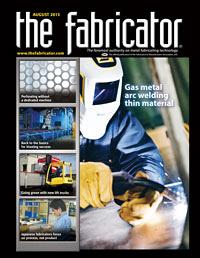Contributing editor
- FMA
- The Fabricator
- FABTECH
- Canadian Metalworking
Categories
- Additive Manufacturing
- Aluminum Welding
- Arc Welding
- Assembly and Joining
- Automation and Robotics
- Bending and Forming
- Consumables
- Cutting and Weld Prep
- Electric Vehicles
- En Español
- Finishing
- Hydroforming
- Laser Cutting
- Laser Welding
- Machining
- Manufacturing Software
- Materials Handling
- Metals/Materials
- Oxyfuel Cutting
- Plasma Cutting
- Power Tools
- Punching and Other Holemaking
- Roll Forming
- Safety
- Sawing
- Shearing
- Shop Management
- Testing and Measuring
- Tube and Pipe Fabrication
- Tube and Pipe Production
- Waterjet Cutting
Industry Directory
Webcasts
Podcasts
FAB 40
Advertise
Subscribe
Account Login
Search
No-, low-emissions lift trucks clear the air
Diesels meet Tier 4; electric ramp up, charge faster, head outdoors
- By Kate Bachman
- August 1, 2013
- Article
- Materials Handling
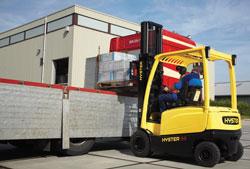
Hyster’s J45-70XN electric lift truck series can be equipped with the company’s Environmental Package, which empowers the electric forklift to work outdoors, even in inclement weather. Photo courtesy of Hyster Co., Cleveland.
Editor’s Note: This feature originally appeared in the March/April 2013 edition of Green Manufacturer, p. 32
Demand for lower vehicle emissions and higher fuel efficiency in the automotive industry has drifted over to vehicles in other industries. Industrial lift trucks are no exception. While more stringent regulatory emissions standards are driving emissions reductions, much of the demand also comes from industry itself.
Many manufacturers’ customers now are requiring suppliers to track emissions. Food production facilities cannot use emissions-producing plant vehicles that would contaminate their food products. In addition, manufacturers are zeroing in on low- and no-emissions and energy-efficient forklifts in pursuit of a cleaner workplace, energy cost savings, general efficiency and productivity improvements, and ISO 14001 and LEED® certifications.
Tier 4 Diesel Engine Exhausts Cleaner
In 1996 (post-Clean Air Act), the U.S. Environmental Protection Agency (EPA) adopted a comprehensive national program—the National Clean Diesel Campaign—to reduce exposure to diesel engine exhaust, including diesel engine forklifts. The program developed as a result of an assessment that linked exhaust fume exposure to serious lung problems, including cancer.
Engine manufacturers must produce engines for diesel-powered forklifts with advanced emission control technologies similar to those already expected for highway trucks and buses. Exhaust emissions from these engines are expected to decrease by more than 90 percent compared to unregulated engines as a result.
Over the past decade, the EPA’s National Clean Diesel Campaign has rolled out a schedule for compliance for the emissions standards for lift truck manufacturers. Tier 4, which went into effect in January 2008, is being phased in through 2013, with allowances for small-volume manufacturers and for existing inventories (see Figure 1). Forklift engine manufacturers have had to submit their Tier 3-to-Tier 4 transition plans to the EPA. Based on their plans, they may continue to sell Tier 3 engines during the transition period under the Flexibility Engine guidelines. Equipment manufacturers can delay the time at which they have to convert to Tier 4 final engines until 2020 or 2021, depending on which provision in the flexibility guidelines they select.
Some of the lift trucks manufacturers that produce diesel-powered trucks, including Hyster® Distribution and Toyota Material Handling, are introducing models to meet the EPA’s Tier 4 standards.
Hyster Co. launched high-capacity lift trucks equipped with Tier 4i/Stage IIIB-compliant diesel engines (an interim stage). Then at ProMat 2013, Hyster launched its 74-HP Tier 4 Final compliant diesel engine equipped with an exhaust gas recirculation (EGR) system and a diesel particulate filter (DPF) to achieve near-zero emissions (see Figure 2). EGR technology eliminates the need for urea or diesel exhaust fluid (DEF)-related equipment and its costs, according to the company.
Toyota’s 8-Series diesel models meet current EPA and CARB emissions standards with a combination of Tier 3 and Interim Tier 4 engines, depending on truck capacity, according to Cesar Jimenez, Toyota Material Handling, U.S.A., Inc.’s national product planning manager. “The 8-series gasoline-, LPG-, and CNG-powered models feature an exclusive emission system that not only surpasses current federal EPA emission standards, but also meets California’s more stringent 2010 emission standards. This results in 70 percent less smog-forming emissions than the EPA Tier 3 standards permit and meets the more stringent EPA Interim Tier 4 emission standards, which emit 26 percent less particulate matter than the Tier 3 standard.”
The 8-series lift trucks are powered by the manufacturer’s 4Y and 1DZ-III engines, which have a closed-loop fuel system design that automatically adjusts and optimizes the air-fuel mixture ratio. Working in conjunction with a three-way catalytic muffler, the system minimizes such harmful emissions as hydrocarbons (HC), oxides of nitrogen (NOx), and carbon monoxide (CO). The models are 100 percent cadmium- and mercury-free.
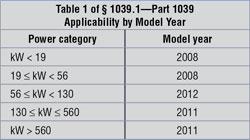
Figure 1: Part 1039 of the EPA’s National Clean Diesel Campaign regulation applies to nonroad, compression-ignition engines subject to the emission standards, starting with the power category and model years noted. Chart courtesy of the U.S Environmental Protection Agency.
Toyota will introduce a new 8-series lift truck engine to meet the Tier 4 Final emission requirements later this year.
Current EPA-, CARB-compliant Lift Trucks
Other manufacturers make currently EPA- and CARB-compliant Class IV or Class V models that are considered low-emission forklifts, even though they are not Tier 4-compliant. “All of Nissan’s forklifts that are powered by a gas, LPG, or dual-fuel are 2013-EPA compliant and are very low-emission forklifts,” said Wayne Wilde Sr., field technical sales officer, Nissan Forklift Corp. “Nissan Forklift has been one of the first forklift manufacturers to have our own engines certified by EPA and CARB,” he added.
Wilde said that Nissan Forklift’s internal-combustion engines generate emissions at a lower amount than current standards set by EPA and CARB. “As part of the annual recertification, for both EPA and CARB, Nissan Forklift’s engines are tested to ensure that their carbon monoxide (CO) and hydrocarbon + nitrous oxide (HC+NOx) emission levels are below the EPA/CARB standards.
Nissan Forklift plans to release a Tier 4 diesel engine in early 2014.
All Yale® ICE model lift trucks meet or exceed applicable market-specific emissions standards, according to the company.
Electric Lift Trucks Power up, Nudge ICEs
Of course, electric-powered lift trucks avoid the Tier 4 emissions requirements altogether because they generate zero in-plant emissions, drawing their power from onboard batteries. Because they don’t exhaust emissions, electric lift trucks have long been a staple in food and beverage plants and often are preferred indoors because they have low noise output.
The Industrial Truck Association (ITA) tracks shipments of the electric and combustion engine forklift classes sold in the U.S. (see Figure 3). Electric-powered lift trucks, including motorized hand trucks (Classes 1, 2, and 3), have surpassed market share on internal combustion engine (ICE) (Classes 4 and 5) lift trucks since the 1980s and continue to grow in popularity.
Electric lift truck technology has advanced significantly, expanding its usefulness and applications.
“Electric lift trucks are continually evolving, and the performance gap between ICE and electric trucks is narrowing. With AC power, electric lift trucks are able to have more consistent power throughout the battery charge. With increased power, these trucks are able to provide higher levels of performance when compared to previous DC systems,” Jimenez said (see Figure 4). “However, there will always be a need in some applications for internal combustion lift trucks to climb ramps and handle heavy loads.”
Nissan Forklift launched its QX series of 80-VAC-powered electric trucks in mid-2010. They offer improved lift speeds and faster acceleration than the typical 36-V electric, Wilde said. “Its performance is much closer to an ICE truck performance.”
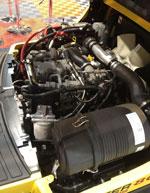
Figure 2: Hyster launched its 74-HP EPA Tier 4 Final-compliant diesel engine equipped with an exhaust gas recirculation (EGR) system and a diesel particulate filter (DPF) to achieve near-zero emissions. Photo courtesy of Hyster Co., Cleveland.
AC Power. Lift truck manufacturers interviewed concur that AC power has advanced the energy efficiency of electric lift trucks dramatically by delivering more runtime per battery charge and maintaining higher levels of performance throughout the work cycle.
“The AC-powered drive system offers operators increased productivity by enabling them to move more pallets per hour and react faster to operator commands,” Jimenez said. “AC motors offer excellent acceleration and top travel speed, loaded or unloaded, and smoother direction changes.”
Raymond, which manufactures an all-electric-powered, no-emissions lift truck fleet, said its AC-powered electric lift trucks offer more productivity, not only because they are AC-powered, but also because their control system is engineered so that lift trucks run longer on a charge.
Jim Hess, national accounts manager for Raymond, explained. “What makes our forklifts more energy-efficient is our control system called ACR. Basically, much like the auto industry, where everybody is trying to go farther on a gallon of gas, our control system does similarly in an electric lift truck.” Hess said the energy efficiency gains have been validated by an independent third party, battery charger manufacturer PosiCharge™, and monitored by United States Auto Club Properties. Several Raymond lift trucks were tested against competitive models by completing the same number of store-and-retrieve cycles and were found to use up to 40 percent less energy.
Hess cited the ACR technology as the cornerstone of the company’s Eco-Performance initiative: “Eco-Performance means doing more with less in terms of energy efficiency, running longer on a battery change,” Hess said, adding that energy efficiencies in forklifts equate to increased productivity. “Longer runtimes mean less time in the battery charging room, and that puts the operator on the floor, moving product more hours a year.”
Regenerative Power. One of the great advantages of AC power is that it facilitates the capability to improve battery efficiency through regenerative power. “All AC power systems utilize regenerative braking by using the kinetic energy of the moving truck to turn the motor, turning it into a generator, which supplies energy back to the battery. This offers increased resistance to slow or stop the moving truck.
The level of resistance—that is, the amount of regenerative braking—is programmable to suit the braking and efficiency needs of the application,” Nissan Forklift’s Wilde said.
Raymond also offers lift trucks with regenerative lowering. “Regenerative lowering can extend operating hours per battery charge on counterbalanced trucks, and regenerative lowering on certain swing-reach trucks can enable up to 40 percent longer operation per charge by feeding the energy of the descending load back to the battery,” Raymond’s Hess said.
Toyota makes a lift truck that recaptures energy while braking, coasting to a stop, changing travel directions, and lowering loads (see Figure 5).
Moving Outdoors. Electric trucks typically are not suited for outdoor use because of the weather elements. Water and electronics don’t mix well. However, some electric forklifts have been engineered to operate in formerly uncharted territories—outdoors and in freezers.

Figure 4: No-emissions, AC-drive motor, battery-powered, counterbalanced lift trucks have powered up with increased lift speeds and higher levels of performance throughout the work cycle than previous generations of electric lift trucks. Photo courtesy of Yale Material Handling Corp
Hyster has introduced a new Environmental Package that allows its electric lift trucks to operate in harsh weather conditions outside of a plant (see lead image). This is suitable for operations with lift trucks operating between buildings and outside, said Jonathan Dawley, president of Hyster Distribution. “Traditionally, this has been a place where electric lift trucks could not play, but with this new package, they are able to do the work of ICE trucks with the added benefits of zero emissions.”
The outdoors-tolerant design is engineered so that electric trucks can operate in heavy-duty areas such as heavy manufacturing plants, dock yards, recycling areas, food preparation and handling, and even in the rain.
Optional precipitation protection includes shielding devices on the sealed drive axle to prevent debris from interfering with operations; motors with belly pan and side shields; sealed bearings and waterproof cover relays and connectors; and mud guards on the front fenders to protect the attachment and load from tire-slung debris and water.
Raymond designed a freezer-tolerant forklift that operates when a forklift comes out of a freezer and into an ambient or cool dock and condensation starts to form. “We mastered the condensation problem by how we locate the electronics inside the truck, so they aren’t affected by the condensation and water,” Hess said.
Nissan Forklift has borrowed technology from the automotive industry, battery and chargers, and electronics to improve performance, energy consumption, and emissions, Wilde said. Nissan Forklift has worked with technology-leading motor and controller suppliers to specify and configure the motor and controller combination, to provide horsepower and torque settings that are specifically customized to a particular forklift’s drivetrain, battery voltage/capacity, truck capacity, and speed requirements, to produce a combination of the best performance and efficiency for that vehicle.
Fast Charging. Very possibly, electric forklifts’ biggest evolutionary leap that skyrockets their usefulness happens beyond the forklift frame—at the charging station.
With standard battery charging, operators swap out the battery several times a day, which requires backup batteries and time for the switch-out. Rapid recharger technology eliminates the need to switch out batteries, and so it eliminates the need for and expense of backup batteries. The technology advancement is a game-changer.
In a fast-charge application, batteries are maintained at 30 to 80 percent state of charge (SOC) with periodic charging intervals of one to two hours at a time, according to Nasser Kutkut, Ph.D., co-founder and CTO, PowerDesigners USA, a rapid battery charger manufacturer.
“Not only does this eliminate the need for additional batteries, it improves truck driver productivity as it eliminates the time wasted in changing batteries in two- and three-shift applications. The battery utilization factor jumps to a full 100 percent,” she added.
Ken Sullivan, director of sales and business development for Minit-Charger, also a battery charger manufacturer, confirms. “Rapid rechargers reduce the need for multiple spare batteries, which cost up to $7,000 each. In addition, they eliminate the need for large, ‘conventional charging’ battery rooms with 4,000-lb. batteries and handling equipment and put an end to the dangerous battery-swapping process.”
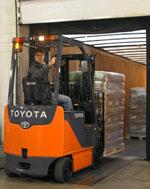
Figure 5: Toyota manufactures a lift truck that recaptures energy while braking, coasting to a stop, changing travel directions, and lowering loads. Photo courtesy of Toyota Material Handling, Irvine, Calif.
The fast chargers have launched a paradigm shift in the way the electric lift trucks are repowered. “They are opportunity chargers that recharge over the course of the day during breaks and lunches,” Sullivan said. Multishift facilities typically have opportunities to recharge, even during short breaks, he added.
“If you operate battery-powered trucks at least 1.5 shifts per day and do at least one battery change-out per day, you may be a candidate for fast charging,” advised Kutkut. “The next step is to fully understand the operational profile of the trucks and batteries to discern whether you can actually use fast charging. This can be established through a power study where the battery/truck operation is monitored throughout the week.”
Minit-Charger claims that its rapid rechargers are engineered so that they can be located almost anywhere, negating the need to go to a separate charging area (see Figure 6). This translates to huge time savings, productivity improvements, and environmental benefits to boot.
Toyota has formed an alliance with AeroVironment, which manufactures PosiCharge fast-charge systems. “It is important for the lift truck to be able to work a full shift without having to charge the battery,” Jimenez said, adding that improvements in the efficiency and life cycle of the battery itself are part of the eco benefit. “An extended life cycle of batteries combined with a company’s reduced battery inventory equates to fewer batteries heading to landfills.”
Disposing of the lead-acid batteries creates an environmental hazard in landfills; however, there is no reason why lead-acid batteries for forklifts must end up in a landfill. East Penn Manufacturing, Pa., which makes thousands of different sizes and types of lead-acid batteries, including lift truck batteries, recycles nearly 100 percent of every used lead-acid battery returned to its ISO 14001-certified facility.
Future Expectations, New Technologies
Several major lift truck and other manufacturers are investigating advanced, more efficient battery chemistries; cleaner-burning alternative fuels; and other technologies in an effort to reduce energy consumption, carbon impact, and toxic material content. It remains to be seen which technologies will prevail.
In 2009 Toyota Industries Corp. launched an internal combustion hybrid lift truck, the Geneo Hybrid, in Japan and recently has released a hybrid pneumatic-ICE lift truck. “Hybrids offer great potential for companies that want to save on fuel but prefer the capabilities of an engine-powered lift truck,” Jimenez said. “This best maximizes the advantages of electric and engine-powered lift trucks.”
Raymond, Hyster, and Toyota have been developing hydrogen fuel cell-powered trucks as an alternative to batteries. Raymond has furnished the lift trucks to customers and has been using the technology in forklifts in its own manufacturing plant in upstate New York for six years. The site houses a filling station where the hydrogen fuel cell-powered lift trucks pull up to a dispenser and fill up the fuel cell in a few minutes.
Toyota offer UL-listed, EPA- and CARB-certified compressed natural gas- (CNG-) powered lift trucks.
Yale says it has consistently engineered its lift trucks to be compatible with the latest in alternative power technologies over the years, including electric batteries, liquid propane, fuel cells, and clean diesels, and offers CNG-powered lift trucks as a factory-installed option to its customers.

Figure 6: Minit-Charger manufactures a rapid charger that it says can be located anywhere in a warehouse. The Minit-Charger® FC system is equipped with a sequenced, dual-port charging option and is specifically designed to charge all the material handling equipment in a warehouse. Photo courtesy of Minit-Charger, Phoenix.
Applied Energy recently introduced its lithium-ion batteries for forklifts, designed to extend runtime on one charge. The lithium-ion material is highly coveted and is likely to be recycled.
All agree that the downward trending of lift truck emissions and energy consumption will need to continue.
“Whether by increased regulation or continued end-user requests, lift trucks with low to no emissions will continue to gain in popularity,” Hyster’s Dawley said.
“Electric and low-emissions lift trucks are a growing segment of the market, and that appears as though it will continue,” said Bill Pfleger, president of Yale Distribution.
“As customers’ needs evolve and regulators’ thresholds for emissions become lower, it will be imperative that the lift truck industry continue to bring reliable and innovative vehicles to market,” Jimenez said.
“Customers themselves are driving the need for greater efficiency, the ability to do more with less,” Hess said. “I think that what we’ll see in the next few years is more lift trucks designed to be more fuel-efficient to meet industry needs.”
Electric lift trucks are upward trending. No doubt, the demand for fast battery chargers will trend upward with them.
Primer
Class 1 —Electric Motor, Counterbalanced Rider
Class 2 —Electric Motor, Narrow Aisle
Class 3 —Electric Motor, Hand
Class 4 —Internal Combustion Engine, Cushion Tire
(Gas, LPG, Duel Fuel)
Class 5 —Internal Combustion Engine, Pneumatic Tire (Gas, LPG, Duel Fuel, Diesel)
LEED®—Leadership in Energy and Environmental Design; a voluntary, consensus-based, market-driven program that provides third-party verification of green buildingsISO 14001—A globally accepted blueprint for an
environmental management systemCARB—The influential California Air Resources Board, which sets its own fuel-efficiency standards for vehicles sold in California
Green Vehicles, Green Manufacturing
Lift truck manufacturers, keenly aware of their customers’ emissions and energy efficiency preferences, are making their products greener by making them in greener plants.
Toyota Industrial Equipment Mfg. (TIEM), Toyota’s lift truck plant in Columbus, Ind., reduced its volatile organic compound (VOC) emissions by 33 percent; hazardous air pollutant (HAP) emissions by 80 percent; energy consumption by 40 percent; and natural gas consumption by 65 percent. In addition, Toyota requires its top 65 suppliers to be ISO14001-certified or have an equivalent EMS, and requests that all suppliers use environmentally friendly materials and processes.
Nissan Forklift Corp. has been ISO 14001-certified, in part by its efforts to reclaim waste heat, install variable-frequency drives and high-efficiency lighting, use returnable containers, and recycle extensively. As a result, it has reduced its carbon dioxide emission by 51 percent, reduced VOC emission by 20 percent, and reduced landfill waste by 88 percent.
All of Yale’s Americas and European manufacturing facilities have achieved ISO 14001 registration in the manufacture of its lift trucks. Each of the locations closely tracks environmental and safety performance and sets objectives each year to drive continual improvement as an integral part of the company’s business plan, according to Yale.
Hyster and Yale have integrated the reuse concept into its product line, introducing a Certified Remanufactured lift truck program this year at ProMat. Trained technicians perform a 200-point inspection and replace key parts on preselected, preowned lift trucks and inspect and replace other parts as needed.
Raymond has been using its hydrogen fuel cell-powered forklifts in its Greene, N.Y., factory for six years to test the technology for long-term negative effects. (Happily, there have been none.)
About the Author

Kate Bachman
815-381-1302
Kate Bachman is a contributing editor for The FABRICATOR editor. Bachman has more than 20 years of experience as a writer and editor in the manufacturing and other industries.
subscribe now

The Fabricator is North America's leading magazine for the metal forming and fabricating industry. The magazine delivers the news, technical articles, and case histories that enable fabricators to do their jobs more efficiently. The Fabricator has served the industry since 1970.
start your free subscription- Stay connected from anywhere

Easily access valuable industry resources now with full access to the digital edition of The Fabricator.

Easily access valuable industry resources now with full access to the digital edition of The Welder.

Easily access valuable industry resources now with full access to the digital edition of The Tube and Pipe Journal.
- Podcasting
- Podcast:
- The Fabricator Podcast
- Published:
- 04/16/2024
- Running Time:
- 63:29
In this episode of The Fabricator Podcast, Caleb Chamberlain, co-founder and CEO of OSH Cut, discusses his company’s...
- Industry Events
16th Annual Safety Conference
- April 30 - May 1, 2024
- Elgin,
Pipe and Tube Conference
- May 21 - 22, 2024
- Omaha, NE
World-Class Roll Forming Workshop
- June 5 - 6, 2024
- Louisville, KY
Advanced Laser Application Workshop
- June 25 - 27, 2024
- Novi, MI
























